Solar Roofs Extend Electric Vehicle Range
The battle to reduce carbon emissions and combat climate change has sparked a revolution in the way we think about transportation. As electric vehicles (EVs) become more popular and affordable, they have the potential to significantly reduce our dependence on fossil fuels. However, even with the advancements in EV technology, one major barrier remains – range anxiety. Thankfully, the solution may lie in an unexpected place – solar roofs. In this article, we will explore how solar roofs can extend the range of electric vehicles, paving the way for a more sustainable future.
The Challenge of Range Anxiety
One of the biggest hurdles for widespread adoption of EVs is range anxiety, or the fear of running out of charge before reaching your destination. Unlike traditional gas-powered vehicles, EVs have a limited range and require frequent charging, making long-distance travel a daunting task for many drivers. This concern over range has limited the potential of EVs and has been a major factor in slowing down their market growth.
Despite advancements in battery technology that have increased the range of EVs, drivers still face a trade-off between range and cost. A larger battery, and thus a longer range, comes with a higher price tag, making EVs less accessible for many consumers. This is where solar roofs provide a promising solution.
How Solar Roofs Can Extend Range
Solar roofs, also known as photovoltaic (PV) roofs, are made up of solar panels that convert sunlight into electricity. This technology has been around for decades, but recent advancements have made it more efficient and affordable. By harnessing the power of the sun, solar roofs can generate electricity to power a vehicle, reducing the reliance on the vehicle’s battery.
One of the main benefits of solar roofs is their ability to charge the vehicle while it’s on the move. This is made possible through a process called regenerative braking, where the car’s kinetic energy is converted into electricity and stored in the battery. However, with a solar roof, this energy can also be directly fed into the battery, further extending the vehicle’s range.
In addition to charging the battery while driving, solar roofs can also be used to charge the vehicle when it’s parked. This is especially useful for EV owners who do not have access to a charging station, allowing them to still top up their battery and extend their range. Some car manufacturers, such as Tesla and Hyundai, have even started incorporating solar panels into the design of their vehicles, further highlighting the potential of solar roofs in increasing range and promoting sustainability.
The Impact on the Environment
Solar roofs not only offer a solution to range anxiety, but they also have a positive impact on the environment. As vehicles powered by renewable energy, they contribute to reducing carbon emissions and mitigating the effects of climate change. Furthermore, with the integration of solar panels into the design of EVs, there is less need for large-scale solar farms, reducing land use and minimizing any negative impacts on the environment.
Moreover, solar roofs are a sustainable energy source, producing electricity without any emissions, noise, or pollution. This is in stark contrast to traditional fossil fuels, which not only emit harmful greenhouse gases but also create air and noise pollution. By switching to solar roofs, we can significantly reduce our carbon footprint and create a cleaner, healthier environment.
The Future of Solar Roofs and EVs
As the world shifts towards more sustainable forms of transportation, the potential for solar roofs and EVs to revolutionize the industry is undeniable. With the continuous advancements in technology, we can expect to see even more efficient and affordable solar roofs, making them even more appealing for EV owners.
Furthermore, governments and institutions around the world are investing heavily in renewable energy solutions and providing incentives for the purchase and use of EVs. This further supports the growth of solar roofs and EVs and promotes a more sustainable future for generations to come.
Conclusion
Solar roofs offer a promising solution to range anxiety and provide a more sustainable option for transportation. By harnessing the sun’s energy, EVs can extend their range and reduce their reliance on traditional charging methods. In addition, solar roofs have a positive impact on the environment, proving to be a win-win solution for both consumers and the planet. As the technology continues to evolve, we can expect to see more widespread adoption of solar roofs and EVs, ultimately leading us towards a cleaner and greener future.










